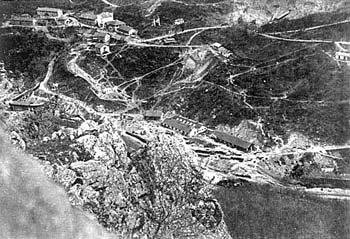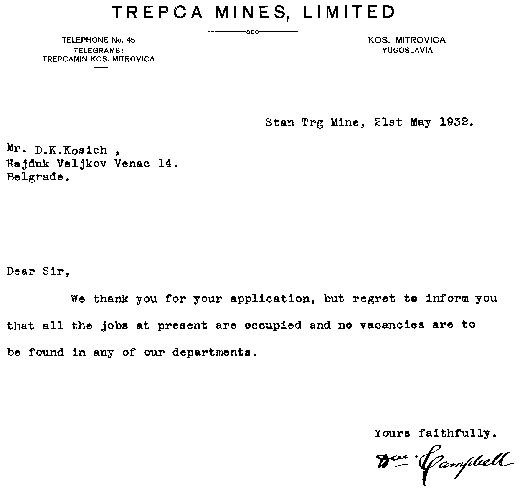
by George Kosich
July/August 1999, vol. XV, no. 6
 |
by George Kosich
July/August 1999, vol. XV, no. 6 |
|
|
An application for employment at Trepca Mines
in Kosovo was made by Dimitrije K. Kosich in May of 1932. Kosich was a
recent returnee to Yugoslavia after having lived in the United States since
1903. He was a skilled blacksmith whose experience in mine drill sharpening
included the mines in the Upper Peninsula of Michigan’s Gogebic area, the
Iron Range of Minnesota, and Montana.
Kosich’s application was rejected on the 21st
of May in 1932, with a typewritten letter in English on stationary with
the heading TREPCA MINES, LIMITED, and signed by Wm. Campbell. The English
management is obvious.
During the inter-war period, like almost all
the past, foreign powers controlled Kosovo’s rich ore mine at Trepca. Such
has been the case almost since the Romans discovered and developed the
valuable ore mines of Kosovo.
For hundreds of years, Kosovo’s Trepca mine
at Zvecan has yielded lead and silver ore, but one of its rarest commodities,
crystals, was not discovered until the mines reached deep underground.
Crystals, which are created by volcanic heat
and extreme pressures, are recognized as one of nature’s rarest artifacts.
In varied, brilliant colors and sculptured geometrical shapes, more than
1,800 crystal specimens were displayed in the Stari TrgMine Museum
near Kosovska Mitrovica. In addition, Trepca’s crystals are valued highly
by museums all over the world.
After the Battle of Kosovo in 1389, the Ottoman
Empire ruled the area for 524 years. During World War II, Kosovo was occupied
by the armies of Germany, Italy and Albania, but the Trepca mines were
owned by German Luftwaffe Marshall Hermann Goehring’s private company.
At the present time, the mines are in NATO’s French-controlled zone.
Unlike management, the miners of Trepca have
been primarily from the Balkans: Orthodox Serbs from Serbia and Kosovo;
Orthodox Serbs from Montenegro; Orthodox Serbs from Lika, in the Krajina;
Albanians of the Catholic, Orthodox or Muslim faiths; Catholic Croats from
Croatia and Dalmatia; and Muslim Bosnians, as well as Orthodox Russians,
all found employment extracting lead, zinc, copper, silver and gold ore
from mines in the Kosovo-Metohija area. These mines are the largest in
Yugoslavia and among the largest in all of Europe.
The letterhead from 1932, shown below, confirms
that one of the mines was called Stan Trg. In her book Black
Lamb and Gray Falcon,author Rebecca West visited Trepca and questioned
her English guide about the name, which everyone concedes should be Stari
Trg,or “Old Market,” rather than Stan Trg.His explanation was:
“...it is simply a mistake. Somebody copied the name wrongly when the mine
was started, and nobody about the place knew enough Serbian to correct
it. But it ought to be Stari.”
The importance of the mineral deposits in
Kosovo obviously outweigh any linguistic trivia, and one can be sure that,
regardless under whose control, the rich mines of Kosovo will continue
to be of vital political and economic interest to Yugoslavia and Europe
for some time to come.
 |
All rights reserved. No part of this publication may be reproduced
without the express written permission of SERB WORLD U.S.A. Copyright
1999 by SERB WORLD U.S.A.
|
Sample Articles |
a Subscription |
Back Issue Titles |
Back Issues |